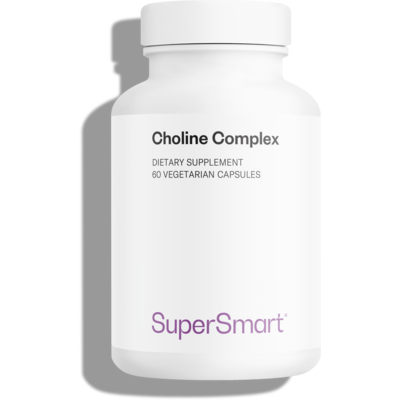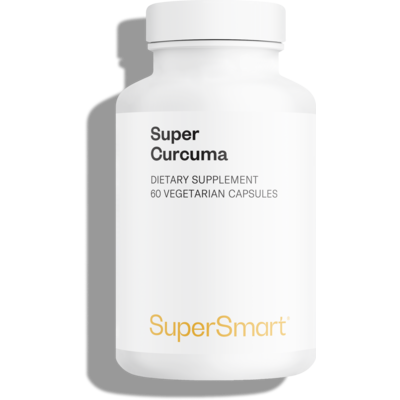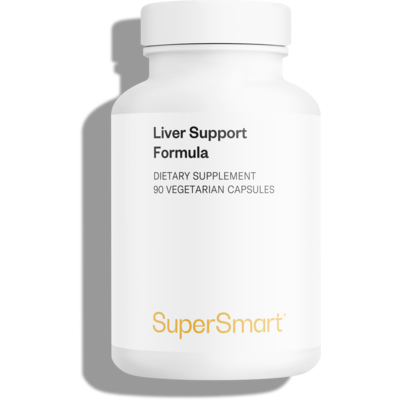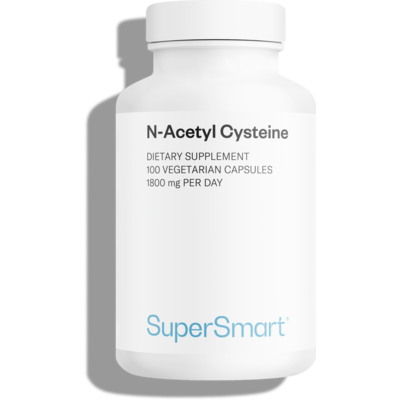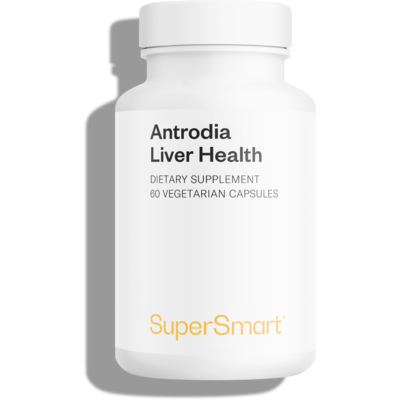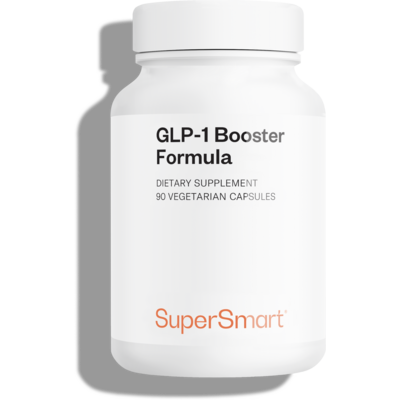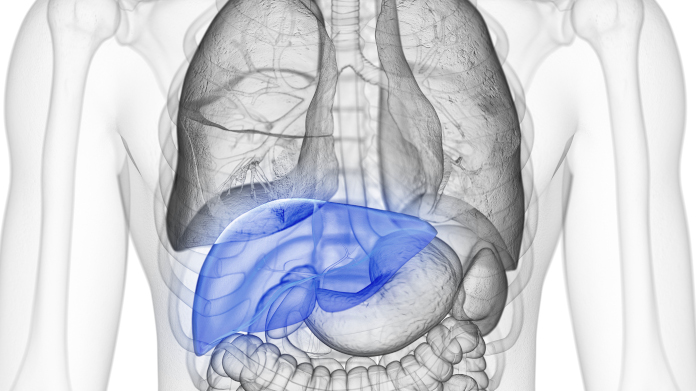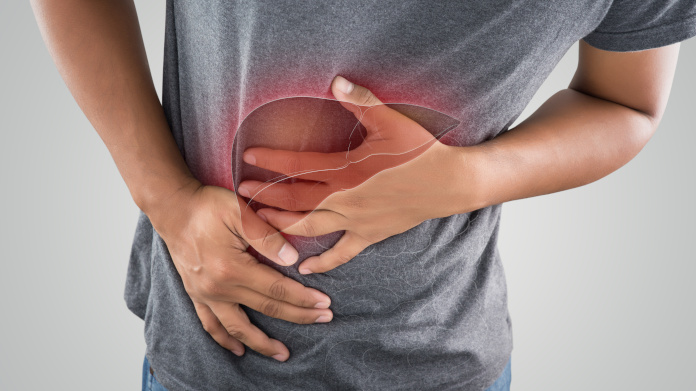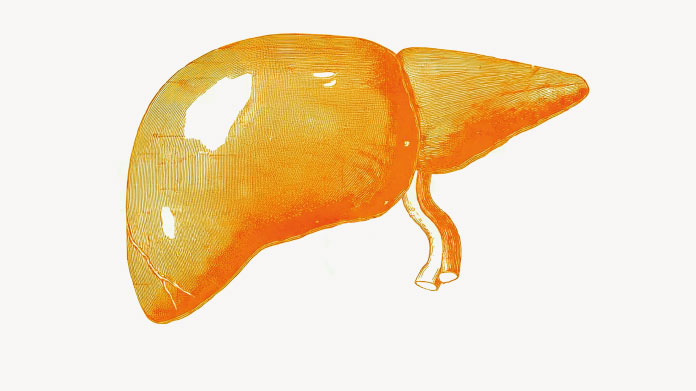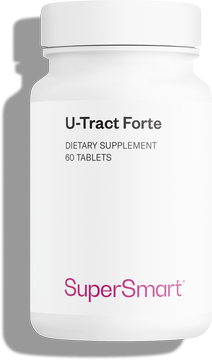GLP-1: a new hope against fatty liver?
More and more people are developing a significant amount of fat in the liver, leading to non-alcoholic liver disease. Research into GLP-1 suggests that it could be seen as helping with this.

Steatohepatitis associated with metabolic dysfunction (MASH): a form of ‘fatty liver disease’
Metabolic dysfunction-associated steatohepatitis (MASH), formerly known as non-alcoholic steatohepatitis (NASH), refers to the excessive accumulation of fat in the liver and its consequences.
It is often referred to as ‘non-alcoholic fatty liver disease’.
When it is overworked, the liver can no longer manage these fats properly. This can lead to inflammation and progressive damage to liver cells.
In some cases, this phenomenon can develop into fibrosis, i.e. the formation of scar tissue in the liver, which is no longer able to carry out the organ's usual functions (detoxification, synthesis of proteins and coagulation factors, regulation of metabolism, etc.) (1).
The final stage of untreated fibrosis is cirrhosis, a disease that is not necessarily linked to alcohol consumption, contrary to what is often thought.
In cirrhosis, much of the liver tissue is replaced by scar tissue. The liver becomes rigid and gradually loses its ability to perform its functions.
Driven by obesity, a sedentary lifestyle and certain metabolic disorders, MASH is increasingly common throughout the world (2).
This is why researchers are looking at new ways of supporting the liver, in particular the use of GLP-1 agonists.
A study on GLP-1 agonists suggests effects on liver fat
Particularly encouraging results
GLP-1 (glucagon-like peptide-1) is a hormone naturally produced by the body. It is known in particular for regulating appetite and blood sugar levels (3).
Certain drugs called GLP-1 agonists, such as semaglutide, mimic its action.
A clinical study published in the New England Journal of Medicine in 2024 (4) showed that, in people with excess fatty liver with mild to moderate fibrosis, administration of semaglutide once a week for 240 weeks was correlated with:
- improvement in liver composition and inflammation without worsening of fibrosis in more than 60% of cases, compared with approximately 34% of subjects on placebo
- reduction in scar tissue without worsening of steatohepatitis in more than 36% of patients, compared with around 22% of those on placebo
- resolution of steatohepatitis with a reduction in fibrosis in 32.7% of patients, compared with 16.1% in the placebo group
- average reduction in body weight of 10.5%, compared with just 2.0% on placebo
The mechanisms that could explain these results
From a medical point of view, these effects on liver health could be explained by several complementary mechanisms:
- a general reduction in body fat, particularly visceral fat in the abdomen and liver, a criterion often associated with improvements in liver parameters (5)
- a reduction in oxidative stress, known to damage liver cells (6)
Although potentially interesting for supporting liver function, GLP-1 agonists are drug treatments that can have side effects (7).
This is why research is also exploring natural ways of stimulating the body's natural secretion of GLP-1, alongside a suitable lifestyle. Because, to date, the most effective strategy for reducing fatty liver remains gradual and lasting weight loss.
![]() Discover the GLP-1 Booster Formula food supplement to naturally support GLP-1 secretion as part of weight loss.
Discover the GLP-1 Booster Formula food supplement to naturally support GLP-1 secretion as part of weight loss.
![]() In the event of proven liver disease or doubt, always seek medical advice before taking any supplements.
In the event of proven liver disease or doubt, always seek medical advice before taking any supplements.
Support liver function naturally
Balanced diet + physical activity: the combo to prevent fat storage
The best way to prevent the accumulation of fat in the liver is to combine a balanced diet with regular exercise to lose weight, and therefore visceral fat (8).
Eating a balanced diet rich in fibre, fruit, vegetables and unsaturated fatty acids helps to limit the storage of fat around the digestive organs, particularly the liver.
Physical activity, even moderate (brisk walking, cycling, swimming), improves glycemic response (9) and encourages the removal of excess fat. What's more, once you've reached your ideal weight, it helps to stabilise the results you've achieved.
Natural ingredients that help support the liver
Today, a number of nutrients, plant extracts and natural ingredients are being studied for their potential role in liver protection and metabolism.
![]() Important: if you suspect liver disease, have a confirmed diagnosis or are taking medication, it is essential to consult your doctor before taking any supplements.
Important: if you suspect liver disease, have a confirmed diagnosis or are taking medication, it is essential to consult your doctor before taking any supplements.
The use of food supplements, even natural ones, can help support the liver in certain cases, but should never replace medical treatment.
Choline: a key player in fat metabolism
Choline plays a part in normal lipid metabolism and in maintaining normal liver function.
Sufficient intakes of choline therefore help to limit the accumulation of fat in certain organs, while helping to keep the liver functioning properly.
Conversely, according to one study, insufficient intakes are correlated with a greater frequency of development of hepatic steatosis (10).
![]() Discover the Choline Complex dietary supplement, a synergistic combination of 3 bioavailable forms of choline.
Discover the Choline Complex dietary supplement, a synergistic combination of 3 bioavailable forms of choline.
N-acetyl-cysteine: a precursor of glutathione
N-acetyl-cysteine (NAC) is a precursor of cysteine, itself a direct precursor of the glutathione produced by the body and considered a major antioxidant.
Today, NAC is being studied for its potential role in protecting liver cells, particularly in non-alcoholic steatohepatitis (11).
![]() Discover N-Acetyl Cysteine, a dietary supplement formulated to provide an optimal dose each day.
Discover N-Acetyl Cysteine, a dietary supplement formulated to provide an optimal dose each day.
Antrodia: a rare mushroom studied for its effects on the liver
Antrodia camphorata is a traditional Asian mushroom, clinically studied for its overall impact on liver health.
Some research suggests that it may support liver detoxification, manage excess fat and protect against various liver lesions (12).
![]() Discover Antrodia Liver Health, a dietary supplement containing ProAntro®, a fermented extract of Antrodia camphorata mycelium validated by two proprietary efficacy studies.
Discover Antrodia Liver Health, a dietary supplement containing ProAntro®, a fermented extract of Antrodia camphorata mycelium validated by two proprietary efficacy studies.
Silymarin: a milk thistle extract with antioxidant properties
Widely documented for its antioxidant effects, silymarin extracted from milk thistle supports liver health and contributes to its detoxifying potential (13).
![]() Discover Liver Support Formula, a food supplement containing silymarin-rich milk thistle and plant extracts studied for their effects on the liver.
Discover Liver Support Formula, a food supplement containing silymarin-rich milk thistle and plant extracts studied for their effects on the liver.
Curcumin: a compound undergoing extensive research
Curcumin, derived from turmeric, is the subject of numerous studies for its antioxidant and anti-inflammatory properties.
It could contribute to digestive comfort and support the liver and biliary function. It is also thought to help digest fats and prevent their accumulation (14).
![]() Discover Super Curcuma, a patented turmeric extract, standardised to 18-22% curcuminoids, and designed to absorb 29 times more curcuminoids than conventional products.
Discover Super Curcuma, a patented turmeric extract, standardised to 18-22% curcuminoids, and designed to absorb 29 times more curcuminoids than conventional products.
SUPERSMART ADVICE
References
- Girish V, John S. Metabolic Dysfunction-Associated Steatotic Liver Disease (MΑSLD). 2025 Aug 9. In: StatPearls [Internet]. Treasure Island (FL): StatPearls Publishing; 2025 Jan–. PMID: 31082077.
- Younossi ZM, Kalligeros M, Henry L. Epidemiology of metabolic dysfunction-associated steatotic liver disease. Clin Mol Hepatol. 2025 Feb;31(Suppl):S32-S50. doi: 10.3350/cmh.2024.0431. Epub 2024 Aug 19. PMID: 39159948; PMCID: PMC11925440.
- Müller TD, Finan B, Bloom SR, D'Alessio D, Drucker DJ, Flatt PR, Fritsche A, Gribble F, Grill HJ, Habener JF, Holst JJ, Langhans W, Meier JJ, Nauck MA, Perez-Tilve D, Pocai A, Reimann F, Sandoval DA, Schwartz TW, Seeley RJ, Stemmer K, Tang-Christensen M, Woods SC, DiMarchi RD, Tschöp MH. Glucagon-like peptide 1 (GLP-1). Mol Metab. 2019 Dec;30:72-130. doi: 10.1016/j.molmet.2019.09.010. Epub 2019 Sep 30. PMID: 31767182; PMCID: PMC6812410.
- Sanyal AJ, Newsome PN, Kliers I, Østergaard LH, Long MT, Kjær MS, Cali AMG, Bugianesi E, Rinella ME, Roden M, Ratziu V; ESSENCE Study Group. Phase 3 Trial of Semaglutide in Metabolic Dysfunction-Associated Steatohepatitis. N Engl J Med. 2025 Jun 5;392(21):2089-2099. doi: 10.1056/NEJMoa2413258. Epub 2025 Apr 30. PMID: 40305708.
- Wilding JPH, Batterham RL, Calanna S, Van Gaal LF, McGowan BM, Rosenstock J, Tran MTD, Wharton S, Yokote K, Zeuthen N, Kushner RF. Impact of Semaglutide on Body Composition in Adults With Overweight or Obesity: Exploratory Analysis of the STEP 1 Study. J Endocr Soc. 2021 May 3;5(Suppl 1):A16–7. doi: 10.1210/jendso/bvab048.030. PMCID: PMC8089287.
- Pan X, Yang L, Wang S, Liu Y, Yue L, Chen S. Semaglutide ameliorates obesity-induced cardiac inflammation and oxidative stress mediated via reduction of neutrophil Cxcl2, S100a8, and S100a9 expression. Mol Cell Biochem. 2024 May;479(5):1133-1147. doi: 10.1007/s11010-023-04784-2. Epub 2023 Jun 15. PMID: 37318712.
- Pillarisetti L, Agrawal DK. Semaglutide: Double-edged Sword with Risks and Benefits. Arch Intern Med Res. 2025;8(1):1-13. doi: 10.26502/aimr.0189. Epub 2025 Jan 10. PMID: 39902055; PMCID: PMC11790292.
- Recchia F, Leung CK, Yu AP, Leung W, Yu DJ, Fong DY, Montero D, Lee CH, Wong SHS, Siu PM. Dose-response effects of exercise and caloric restriction on visceral adiposity in overweight and obese adults: a systematic review and meta-analysis of randomised controlled trials. Br J Sports Med. 2023 Aug;57(16):1035-1041. doi: 10.1136/bjsports-2022-106304. Epub 2023 Jan 20. PMID: 36669870; PMCID: PMC10423480.
- Małkowska P. Positive Effects of Physical Activity. Curr Issues Mol Biol. 2024 May 30;46(6):5467-5487. doi: 10.3390/cimb46060327. PMID: 38920999; PMCID: PMC11202552.
- Corbin KD, Zeisel SH. Choline metabolism provides novel insights into nonalcoholic fatty liver disease and its progression. Curr Opin Gastroenterol. 2012 Mar;28(2):159-65. doi: 10.1097/MOG.0b013e32834e7b4b. PMID: 22134222; PMCID: PMC3601486.
- Yang K, Kim HH, Shim YR, Ryu T, Kim CW. Comprehensive transcriptomic analysis and meta-analysis identify therapeutic effects of N-acetylcysteine in nonalcoholic fatty liver disease. Front Pharmacol. 2023 May 15;14:1186582. doi: 10.3389/fphar.2023.1186582. PMID: 37256235; PMCID: PMC10225598.
- Kim U, Jang SI, Chen PN, Horii S, Wen WC. Hepatoprotective Effect of Antrodia camphorataMycelium Powder on Alcohol-Induced Liver Damage. Nutrients. 2024 Oct 8;16(19):3406. doi: 10.3390/nu16193406. PMID: 39408373; PMCID: PMC11478381.
- Gillessen A, Schmidt HH. Silymarin as Supportive Treatment in Liver Diseases: A Narrative Review. Adv Ther. 2020 Apr;37(4):1279-1301. doi: 10.1007/s12325-020-01251-y. Epub 2020 Feb 17. PMID: 32065376; PMCID: PMC7140758.
- Farzaei MH, Zobeiri M, Parvizi F, El-Senduny FF, Marmouzi I, Coy-Barrera E, Naseri R, Nabavi SM, Rahimi R, Abdollahi M. Curcumin in Liver Diseases: A Systematic Review of the Cellular Mechanisms of Oxidative Stress and Clinical Perspective. Nutrients. 2018 Jul 1;10(7):855. doi: 10.3390/nu10070855. PMID: 29966389; PMCID: PMC6073929.
Keywords
2 Days
Reputable companysearch and the number of…
The research and the number of selection of products.
NAKHJAVAN Shervin
15 Days
The Anti Aromatase is a great product
The Anti Aromatase is a great product. You just need to have constant inventory. Recently this product has been out of stock.
GEORGE Verne
16 Days
Great help on chat
Great help on chat. Knowledgeable and friendly.
Jason Argos
20 Days
Customer service was fast and friendly.
Customer service helped to stop the transaction process of the subscription. I appreciated that.
Greenie
20 Days
I order here due to the high quality of…
I order here due to the high quality of the products and the quick delivery of items - thank you
Barbara J
21 Days
SuperSmart's Eye Pressure supplements: highly recommended!
I purchase SuperSmart's Eye Pressure supplements regularly for over 5 years, and gotta say they are truly a wonderful product for my Glaucoma. Highly recommended if you have eye pain from your Glaucoma.
D. Martinez
26 Days
Quick service
Quick service
MONELL
27 Days
Speedy service.
Speedy service.
ROSENTHAL Marvin
30 Days
Clear website- Efficient
Clear website. Excellent search engine and fast delivery!
Mohamad Hussein
33 Days
They have great products.
They have great products.
Vickie
33 Days
Great Shipping Time!
You Have A Great Shipping Time! Praise The Lord!
DMHoge
35 Days
Doctor Recommended!
Good pricing, very good availability, doctor recommended (couldn't find what I needed anywhere else), and it took only a week to arrive (which I can't complain about).
Al
36 Days
Great product and fast shipping
Great product and fast shipping
Marie
37 Days
New customer 1
I got my order fast and on time.
SA
37 Days
Great Service
Fast, good communication, as promised.
Juli

